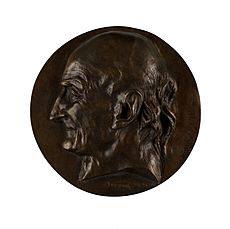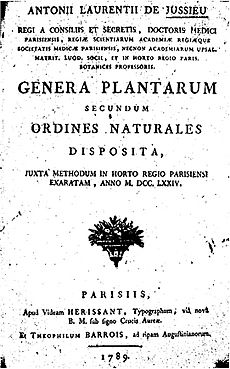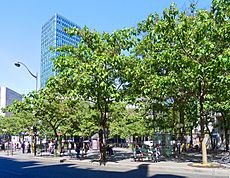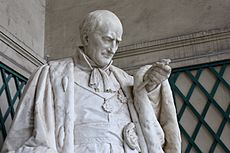Antoine Laurent de Jussieu facts for kids
Quick facts for kids
Antoine Laurent de Jussieu
|
|
|---|---|

Sketch portrait, probably by Jules Pizzetta.
|
|
| Born | 12 April 1748 |
| Died | 17 September 1836 (aged 88) Paris, July Monarchy
|
| Nationality | French |
| Known for | Classification of flowering plants |
| Scientific career | |
| Fields | Botany |
| Institutions | Jardin des Plantes, Muséum national d'histoire naturelle |
| Influences | Linnaeus, Michel Adanson, Joseph Gärtner |
| Influenced | Robert Brown, Georges Cuvier, A. P. de Candolle |
| Author abbrev. (botany) | Juss. |
| Children |
|
| Relatives |
|
| Signature | |
 |
|

Antoine Laurent de Jussieu (born April 12, 1748 – died September 17, 1836) was a famous French botanist. He was the first to create a natural way to group and classify flowering plants. Much of his system is still used by scientists today. His ideas were based on the earlier, unshared work of his uncle, Bernard de Jussieu, who was also a botanist.
About Antoine Laurent de Jussieu
Antoine Laurent de Jussieu was born in Lyon, France, in 1748. He was one of ten children. His father, Christophle de Jussieu, was interested in plants. Antoine also had three uncles who were well-known botanists.
Early Life and Education
In 1765, Antoine moved to Paris to live with his uncle Bernard. He studied medicine and earned his doctorate in 1770. His main study was about how animals and plants work.
His uncle helped him get a job at the Jardin du Roi (King's Garden). Here, Antoine became a botany teacher and assistant professor. He gave popular lectures on plants, especially to people studying to be pharmacists.
In 1773, he gave an important lecture about classifying a group of plants called Ranunculaceae. This led to him becoming a member of the Académie des Sciences (Academy of Sciences) that same year.
During the French Revolution
Antoine Laurent de Jussieu's major book, Genera plantarum, came out in 1789. This was just before the French Revolution began. Jussieu supported the revolution's ideas.
He was given a role in the Paris city government. His job was to manage all the hospitals in the city. When the king was removed, the Jardin du Roi was renamed the Jardin des Plantes. Jussieu helped turn it into the Muséum national d'histoire naturelle (National Museum of Natural History) in 1790. He became a professor of botany there.
He also served as the museum's director from 1794 to 1795, and again from 1798 to 1800. Jussieu quickly started building a large collection of dried plant samples, called a herbarium. This was made easier because revolutionary armies seized collections from other countries. They also took items from churches and rich families.
In 1808, Napoleon made him an advisor to the university. Antoine stayed at the museum until 1826. His son, Adrien-Henri de Jussieu, took over his position.
Jussieu's Work on Plant Classification

Jussieu's most important work was his system for classifying plants. It was based on looking at many different features of plants. This system became the foundation for how we classify plants naturally today.
Developing the System
He first shared his classification ideas in 1773, focusing on the Ranunculaceae plant family. The next year, he expanded his ideas. He used his uncle Bernard's work at the Trianon garden in Versailles as a guide. This early work mainly focused on larger groups of plants, above the family level.
For the next five years, Jussieu worked on applying his ideas to all known plants. This led to his most famous book, Genera plantarum, published in 1789. To write this book, he studied many plant collections and botanical gardens.
At first, botanists in Britain and Germany were careful about his ideas. They were used to the system created by Carl Linnaeus. But soon, Jussieu's work became widely accepted in science. Famous botanists like Robert Brown and A. P. de Candolle helped spread his ideas.
How Jussieu's System Worked
In Genera plantarum, Jussieu used a method of looking at many different plant features to define groups. This idea came from another naturalist, Michel Adanson. This was a big improvement over the "artificial" system of Carl Linnaeus. Linnaeus's popular system grouped plants mainly by the number of stamens and pistils (parts of a flower). However, Jussieu still used Linnaeus's system of giving plants two names (like Homo sapiens).
Jussieu expanded on his uncle's ideas about how important different plant features are. He believed some features were more important than others. He said that plant features should be pesés et non comptés (weighed, not counted). This meant you should judge their importance, not just count them.
He named his uncle's three main plant groups: Acotyledon, Monocotyledon, and Dicotyledon. These were then divided into fifteen classes and one hundred families. The most important parts of Genera plantarum are these groups and the detailed descriptions of the 100 plant families.
After returning to scientific work at the museum, Jussieu wrote many papers. These papers further explained the ideas from Genera plantarum. He also gave more detailed descriptions of the plant families he had named. This work was greatly influenced by Joseph Gärtner.
Awards and Memberships
Antoine Laurent de Jussieu was recognized for his important work.
- He became a member of the French Académie des Sciences in 1773.
- He was elected a foreign member of the Royal Swedish Academy of Sciences in 1788.
Jussieu's Lasting Impact
Jussieu's book, Genera Plantarum, published on August 4, 1789, changed how plants are named and grouped. Many of the plant families we use today were first described by Jussieu.
A book called History of botanical science (1981) notes that 76 of Jussieu's plant families are still used today. In comparison, only 11 of Linnaeus's families are still used.
A botanist named Sydney Howard Vines once said that Jussieu deserves all the credit for this great achievement. He called Jussieu "the capable man who appeared precisely at the psychological moment."
Antoine Laurent de Jussieu and his family are remembered in many ways.
- There is a bust (a sculpture of his head and shoulders) and a medallion by David d'Angers.
- A statue of Jussieu stands in the Galerie de Botanique at the Jardin des Plantes. It was made by Jean-François Legendre-Héral in 1842.
- Another statue is on the balustrade (a row of small columns) of the Natural History Museum, Vienna.
- The Jussieu family is also remembered in Paris. There is a Place Jussieu (Jussieu Square), Rue Jussieu (Jussieu Street), the Jussieu metro station, and the Jussieu science campus of the University of Paris.
- Streets in Marseilles and Lyon, their family home, are also named after them.
- The Jussieu Peninsula in South Australia is named after Antoine Laurent Jussieu.
- Even an asteroid is named after him!
See also
 In Spanish: Antoine-Laurent de Jussieu para niños
In Spanish: Antoine-Laurent de Jussieu para niños
- De Jussieu system
- History of botany
- Royal Commission on Animal Magnetism
- Category:Taxa named by Antoine Laurent de Jussieu
Images for kids






